最新冀教版小学三年级英语下册教案(全册)
- 格式:docx
- 大小:88.06 KB
- 文档页数:39
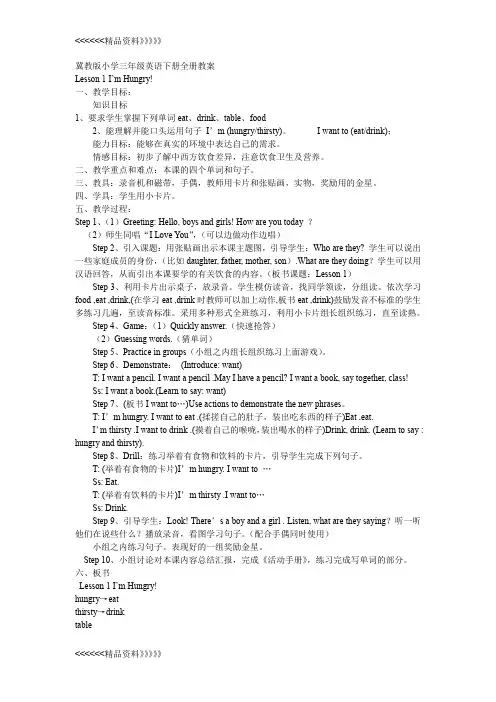
冀教版小学三年级英语下册全册教案Lesson 1 I’m Hungry!一、教学目标:知识目标1、要求学生掌握下列单词eat、drink、table、food2、能理解并能口头运用句子I’m (hungry/thirsty)。
I want to (eat/drink);能力目标:能够在真实的环境中表达自己的需求。
情感目标:初步了解中西方饮食差异,注意饮食卫生及营养。
二、教学重点和难点:本课的四个单词和句子。
三、教具:录音机和磁带,手偶,教师用卡片和张贴画,实物,奖励用的金星。
四、学具:学生用小卡片。
五、教学过程:Step 1、(1)Greeting: Hello, boys and girls! How are you today ?(2)师生同唱“I Love You”,(可以边做动作边唱)Step 2、引入课题:用张贴画出示本课主题图,引导学生:Who are they? 学生可以说出一些家庭成员的身份,(比如daughter, father, mother, son).What are they doing?学生可以用汉语回答,从而引出本课要学的有关饮食的内容。
(板书课题:Lesson 1)Step 3、利用卡片出示桌子,放录音。
学生模仿读音,找同学领读,分组读。
依次学习food ,eat ,drink,(在学习eat ,drink时教师可以加上动作,板书eat ,drink)鼓励发音不标准的学生多练习几遍,至读音标准。
采用多种形式全班练习,利用小卡片组长组织练习,直至读熟。
Step 4、Game:(1)Quickly answer.(快速抢答)(2)Guessing words.(猜单词)Step 5、Practice in groups(小组之内组长组织练习上面游戏)。
Step 6、Demonstrate:(Introduce: want)T: I want a pencil. I want a pencil .May I have a pencil? I want a book, say together, class!Ss: I want a book.(Learn to say: want)Step 7、(板书I want to…)Use actions to demonstrate the new phrases。
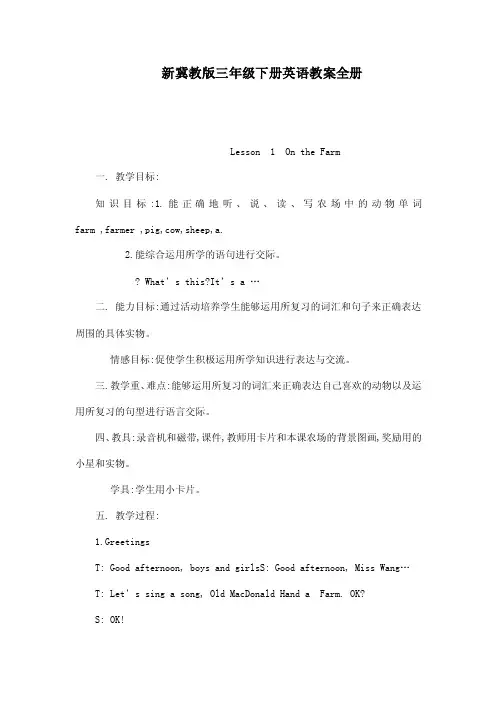
新冀教版三年级下册英语教案全册Lesson 1 On the Farm一. 教学目标:知识目标:1.能正确地听、说、读、写农场中的动物单词farm ,farmer ,pig,cow,sheep,a.2.能综合运用所学的语句进行交际。
? What’s this?It’s a …二. 能力目标:通过活动培养学生能够运用所复习的词汇和句子来正确表达周围的具体实物。
情感目标:促使学生积极运用所学知识进行表达与交流。
三.教学重、难点:能够运用所复习的词汇来正确表达自己喜欢的动物以及运用所复习的句型进行语言交际。
四、教具:录音机和磁带,课件,教师用卡片和本课农场的背景图画,奖励用的小星和实物。
学具:学生用小卡片。
五. 教学过程:1.GreetingsT: Good afternoon, boys and girlsS: Good afternoon, Miss Wang…T: Let’s sing a song, Old MacDonald Hand a Farm. OK?S: OK!设计意图: 营造活跃轻松的课前气氛,使学生带着积极的心态投入到学习中去,英文歌曲也为下面的复习做铺垫。
2.Review the animalsStep1. Show the animals.T: Do you want to visit Old MacDonald Now, let’s go to his farm.(课件出示Old MacDonald图片和农场里的动物们。
)T: Look! Old McDonald is coming! Say hello to him.Ss: Hello, MacDonald!T: Look! There are a lot of animals on his farm,what are these?Step2. Ask and answer to review the animals.T: What’s this?Ss: It’s a sheep/cow/pig…板书:?What’s this??It’s a pig.Ask the student to spell the important words.Step3.Practice in pairs and present the dialogues.What’s thisIt’s a…Step4.Play games(课件展示游戏)1What’s missing?2Match the animals and the pictures.Step5.Take out the text paper and finish number 1.设计意图:这四个步骤,通过课件给学生创设去农场参观的情境,自然引入到本课的复习中;通过学生认读,师生对话,同桌互练,做游戏和完成练习题一等活动方式,扎扎实实的进行动物单词的听、说、读、写训练,帮助学生巩固已学知识。

Lesson 1 On the Farm一. 教学目标:知识目标:1.能正确地听、说、读、写农场中的动物单词 farm ,farmer ,pig,cow,sheep,a.2.能综合运用所学的语句进行交际。
—What’s this?—It’s a …二. 能力目标:通过活动培养学生能够运用所复习的词汇和句子来正确表达周围的具体实物。
情感目标:促使学生积极运用所学知识进行表达与交流。
三.教学重、难点:能够运用所复习的词汇来正确表达自己喜欢的动物以及运用所复习的句型进行语言交际。
四、教具:录音机和磁带,课件,教师用卡片和本课农场的背景图画,奖励用的小星和实物。
学具:学生用小卡片。
五. 教学过程:1.GreetingsT: Good afternoon, boys and girls.S: Good afternoon, Miss W ang…T: Let’s sing a song, Old M acDonald Hand a Farm. OK?S: OK!(设计意图: 营造活跃轻松的课前气氛,使学生带着积极的心态投入到学习中去,英文歌曲也为下面的复习做铺垫。
)2.Review the animalsStep1. Show the animals.T: Do you want to visit Old MacDonald?Now, let’s go to his farm.(课件出示Old MacDonald图片和农场里的动物们。
)T: look! Old McDonald is coming! Say hello to him.Ss: Hello, MacDonald!T: look! There are a lot of animals on his farm,what are these?Step2. Ask and answer to review the animals.T: What’s this?Ss: It’s a sheep/cow/pig…板书:—What’s this?—It’s a pig.Ask the student to spell the important words.Step3.Practice in pairs and present the dialogues.What’s this? It’s a…Step4.Play games(课件展示游戏)1. What’s missing?2. Match the animals and the pictures.Step5.Take out the text paper and finish number 1.(设计意图:这四个步骤,通过课件给学生创设去农场参观的情境,自然引入到本课的复习中;通过学生认读,师生对话,同桌互练,做游戏和完成练习题一等活动方式,扎扎实实的进行动物单词的听、说、读、写训练,帮助学生巩固已学知识。
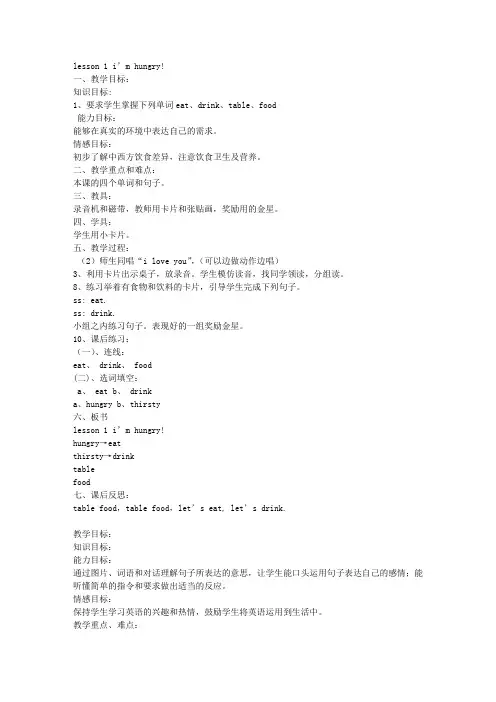
lesson 1 i’m hungry!一、教学目标:知识目标:1、要求学生掌握下列单词eat、drink、table、food能力目标:能够在真实的环境中表达自己的需求。
情感目标:初步了解中西方饮食差异,注意饮食卫生及营养。
二、教学重点和难点:本课的四个单词和句子。
三、教具:录音机和磁带,教师用卡片和张贴画,奖励用的金星。
四、学具:学生用小卡片。
五、教学过程:(2)师生同唱“i love you”,(可以边做动作边唱)3、利用卡片出示桌子,放录音。
学生模仿读音,找同学领读,分组读。
8、练习举着有食物和饮料的卡片,引导学生完成下列句子。
ss: eat.ss: drink.小组之内练习句子。
表现好的一组奖励金星。
10、课后练习:(一)、连线:eat、 drink、 food(二)、选词填空:a、 eatb、 drinka、hungryb、thirsty六、板书lesson 1 i’m hungry!hungry→eatthirsty→drinktablefood七、课后反思:table food,table food,let’s eat, let’s drink.教学目标:知识目标:能力目标:通过图片、词语和对话理解句子所表达的意思,让学生能口头运用句子表达自己的感情;能听懂简单的指令和要求做出适当的反应。
情感目标:保持学生学习英语的兴趣和热情,鼓励学生将英语运用到生活中。
教学重点、难点:本课的八个单词和句子。
教学媒体:录音机和磁带、课件、教师用卡片、教学相关的图片或实物。
教学过程:1. greeting.(视频播放,让学生在情景中回顾所学知识,有助于学生对知识的进一步理解。
歌曲的引入,调动学生的学习积极性,活跃课堂气氛。
)(通过反复朗读加深对单词的记忆。
)(通过幻灯片展示,从视觉上让学生理解记忆。
)game time:(2)use the things around you(游戏的练习,既调动学生的兴趣,将所学知识灵活运用于生活。
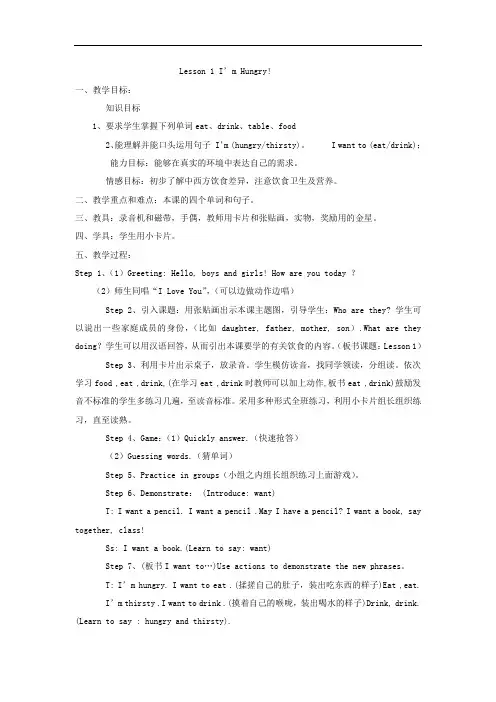
Lesson 1 I’m Hungry!一、教学目标:知识目标1、要求学生掌握下列单词eat、drink、table、food2、能理解并能口头运用句子 I’m (hungry/thirsty)。
I want to (eat/drink);能力目标:能够在真实的环境中表达自己的需求。
情感目标:初步了解中西方饮食差异,注意饮食卫生及营养。
二、教学重点和难点:本课的四个单词和句子。
三、教具:录音机和磁带,手偶,教师用卡片和张贴画,实物,奖励用的金星。
四、学具:学生用小卡片。
五、教学过程:Step 1、(1)Greeting: Hello, boys and girls! How are you today ?(2)师生同唱“I Love You”,(可以边做动作边唱)Step 2、引入课题:用张贴画出示本课主题图,引导学生:Who are they? 学生可以说出一些家庭成员的身份,(比如daughter, father, mother, son).What are they doing?学生可以用汉语回答,从而引出本课要学的有关饮食的内容。
(板书课题:Lesson 1) Step 3、利用卡片出示桌子,放录音。
学生模仿读音,找同学领读,分组读。
依次学习food ,eat ,drink,(在学习eat ,drink时教师可以加上动作,板书eat ,drink)鼓励发音不标准的学生多练习几遍,至读音标准。
采用多种形式全班练习,利用小卡片组长组织练习,直至读熟。
Step 4、Game:(1)Quickly answer.(快速抢答)(2)Guessing words.(猜单词)Step 5、Practice in groups(小组之内组长组织练习上面游戏)。
Step 6、Demonstrate: (Introduce: want)T: I want a pencil. I want a pencil .May I have a pencil? I want a book, say together, class!Ss: I want a book.(Learn to say: want)Step 7、(板书I want to…)Use actions to demonstrate the new phrases。
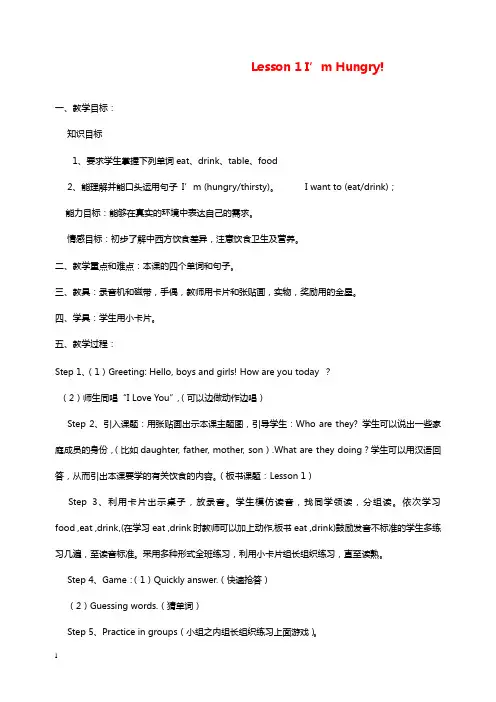
Lesson 1 I’m Hungry!一、教学目标:知识目标1、要求学生掌握下列单词eat、drink、table、food2、能理解并能口头运用句子I’m (hungry/thirsty)。
I want to (eat/drink);能力目标:能够在真实的环境中表达自己的需求。
情感目标:初步了解中西方饮食差异,注意饮食卫生及营养。
二、教学重点和难点:本课的四个单词和句子。
三、教具:录音机和磁带,手偶,教师用卡片和张贴画,实物,奖励用的金星。
四、学具:学生用小卡片。
五、教学过程:Step 1、(1)Greeting: Hello, boys and girls! How are you today ?(2)师生同唱“I Love You”,(可以边做动作边唱)Step 2、引入课题:用张贴画出示本课主题图,引导学生:Who are they? 学生可以说出一些家庭成员的身份,(比如daughter, father, mother, son).What are they doing?学生可以用汉语回答,从而引出本课要学的有关饮食的内容。
(板书课题:Lesson 1)Step 3、利用卡片出示桌子,放录音。
学生模仿读音,找同学领读,分组读。
依次学习food ,eat ,drink,(在学习eat ,drink时教师可以加上动作,板书eat ,drink)鼓励发音不标准的学生多练习几遍,至读音标准。
采用多种形式全班练习,利用小卡片组长组织练习,直至读熟。
Step 4、Game:(1)Quickly answer.(快速抢答)(2)Guessing words.(猜单词)Step 5、Practice in groups(小组之内组长组织练习上面游戏)。
Step 6、Demonstrate:(Introduce: want)T: I want a pencil. I want a pencil .May I have a pencil? I want a book, say together, class!Ss: I want a book.(Learn to say: want)Step 7、(板书I want to…)Use actions to demonstrate the new phrases。
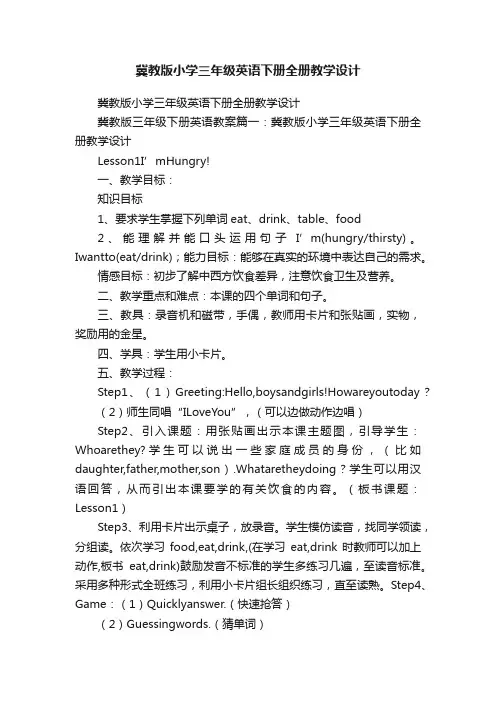
冀教版小学三年级英语下册全册教学设计冀教版小学三年级英语下册全册教学设计冀教版三年级下册英语教案篇一:冀教版小学三年级英语下册全册教学设计Lesson1I’mHungry!一、教学目标:知识目标1、要求学生掌握下列单词eat、drink、table、food2、能理解并能口头运用句子I’m(hungry/thirsty)。
Iwantto(eat/drink);能力目标:能够在真实的环境中表达自己的需求。
情感目标:初步了解中西方饮食差异,注意饮食卫生及营养。
二、教学重点和难点:本课的四个单词和句子。
三、教具:录音机和磁带,手偶,教师用卡片和张贴画,实物,奖励用的金星。
四、学具:学生用小卡片。
五、教学过程:Step1、(1)Greeting:Hello,boysandgirls!Howareyoutoday?(2)师生同唱“ILoveYou”,(可以边做动作边唱)Step2、引入课题:用张贴画出示本课主题图,引导学生:Whoarethey?学生可以说出一些家庭成员的身份,(比如daughter,father,mother,son).Whataretheydoing?学生可以用汉语回答,从而引出本课要学的有关饮食的内容。
(板书课题:Lesson1)Step3、利用卡片出示桌子,放录音。
学生模仿读音,找同学领读,分组读。
依次学习food,eat,drink,(在学习eat,drink时教师可以加上动作,板书eat,drink)鼓励发音不标准的学生多练习几遍,至读音标准。
采用多种形式全班练习,利用小卡片组长组织练习,直至读熟。
Step4、Game:(1)Quicklyanswer.(快速抢答)(2)Guessingwords.(猜单词)Step5、Practiceingroups(小组之内组长组织练习上面游戏)。
Step6、Demonstrate:(Introduce:want)T:Iwantapencil.Iwantapencil.MayIhaveapencil?Iwantabook,s aytogether,class!Ss:Iwantabook.(Learntosay:want)Step7、(板书Iwantto?)Useactionstodemonstratethenewphrases。
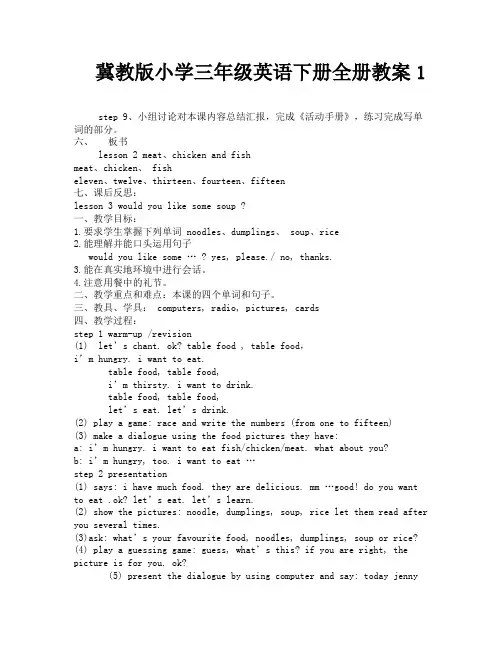
冀教版小学三年级英语下册全册教案1step 9、小组讨论对本课内容总结汇报,完成《活动手册》,练习完成写单词的部分。
六、板书lesson 2 meat、chicken and fishmeat、chicken、 fisheleven、twelve、thirteen、fourteen、fifteen七、课后反思:lesson 3 would you like some soup ?一、教学目标:1.要求学生掌握下列单词 noodles、dumplings、 soup、rice2.能理解并能口头运用句子would you like some … ? yes, please./ no, thanks.3.能在真实地环境中进行会话。
4.注意用餐中的礼节。
二、教学重点和难点:本课的四个单词和句子。
三、教具、学具: computers, radio, pictures, cards四、教学过程:step 1 warm-up /revision(1) let’s chant. ok? table food , table food,i’m hungry. i want to eat.table food, table food,i’m thirsty. i want to drink.table food, table food,let’s eat. let’s drink.(2) play a game: race and write the numbers (from one to fifteen)(3) make a dialogue using the food pictures they have:a: i’m hungry. i want to eat fish/chicken/meat. what about you?b: i’m hungry, too. i want to eat …step 2 presentation(1) says: i have much food. they are delicious. mm …good! do you wantto eat .ok? let’s eat. let’s learn.(2) show the pictures: noodle, dumplings, soup, rice let them read after you several times.(3)ask: what’s your favourite food, noodles, dumplings, soup or rice?(4) play a guessing game: guess, what’s this? if you are right, the picture is for you. ok?(5) present the dialogue by using computer and say: today jennycomes li ming’s house for supper. what do they eat? let’s look. then let them act it out.(6) says: do you want to be a host? how to treat your little guest. look carefully. present t he dialogue of number 2. explain “some more ”.then let the students say after the tape or computer.step 3 practice(1) practice the dialogue in three:a: would you like some …? b: yes, please. /no, thanks.a: are you hungry now? b: no.(2) act it out. at last you may find out which is the best gust. give them some flowers.step 4 assessment(1) to have an interview with their families and friends using the dialogue we have learned.(2) draw and write down the food you like.五、板书 lesson 3 would you like some soup ?noodles。

三年级下册英语教案冀教版教案标题:三年级下册英语教案冀教版教学目标:1. 能够听懂、会说、会读、会写本单元的生词和句型。
2. 能够正确运用所学内容进行简单的对话和交流。
3. 培养学生的英语学习兴趣,提高他们的学习主动性和积极性。
教学重点:1. 学习并掌握本单元的生词和句型。
2. 进行听力训练,提高学生的听力理解能力。
3. 进行口语训练,培养学生的口语表达能力。
教学准备:教材:冀教版三年级下册英语教材教具:录音机、图片、课件、小黑板教学过程:Step 1: Warm-up (热身活动)1. Greet the students and review the previous lesson by asking questions about the topic.2. Play a warm-up game, such as "Simon Says," to get the students engaged and ready for the lesson.Step 2: Presentation (呈现)1. Introduce the new vocabulary words and phrases for the unit using flashcards or pictures.2. Use real-life examples and gestures to help students understand the meanings of the words and phrases.3. Practice pronunciation and repeat the words and phrases together as a class. Step 3: Listening (听力训练)1. Play the audio recording of the dialogue or story for the unit.2. Ask students to listen carefully and answer questions about the content.3. Play the audio recording again, pausing at certain points for students to repeat and practice.Step 4: Speaking (口语训练)1. Divide the class into pairs or small groups.2. Provide speaking prompts or role-play scenarios related to the unit's content.3. Encourage students to use the new vocabulary and sentence patterns in their conversations.4. Monitor and provide feedback to individual students or groups as they practice speaking.Step 5: Reading and Writing (阅读和写作)1. Have students read the text or passages related to the unit.2. Ask comprehension questions to check their understanding.3. Assign writing tasks, such as completing sentences or writing short paragraphs using the new vocabulary and sentence patterns.Step 6: Consolidation and Review (巩固和复习)1. Review the key points, vocabulary, and sentence patterns covered in thelesson.2. Play review games, such as "Word Bingo" or "Hangman," to reinforce the learning.3. Assign homework tasks, such as reviewing the vocabulary or practicing the dialogue at home.Step 7: Assessment (评估)1. Conduct a short quiz or oral assessment to evaluate students' understanding and progress.2. Provide feedback and guidance to individual students based on their performance.Step 8: Closure (结束)1. Summarize the lesson and review the main points covered.2. Encourage students to ask any remaining questions or share their thoughts on the lesson.3. Assign any necessary homework or preview for the next lesson.教学扩展:1. 利用多媒体资源,如视频、音频等,增加教学的趣味性和多样性。

冀教版三年级下册英语教案5篇冀教版三年级下册英语教案1一、教学内容Let’sChant二、教学目标(一)语言技能目标1、能理解小诗的意义,并能朗读小诗。
2、能够表演小诗。
(二)学习策略目标1、在学习新单词时要注意观察老师的发音,乐于模仿。
2、建立起词组和方位之间的联想,能根据发音认出相应的词组。
3、借助情景,理解新知识。
4、积极参加活动,大胆表现自己。
(三)情感态度目标1、通过玩游戏、读小诗培养学生的学习兴趣,使学生产生爱上英语课的积极情感。
2、通过学习,加深过马路要遵守交通规则的意识。
三、教学策略1、通过模拟的场景,加深学生对小诗的印象。
2、通过游戏、练习,帮助学生认读词组。
3、在学生输出语言前为他们提供大量的语言输入,为学生输出语言提供坚实的保障。
四、教学重点和难点教学重点:朗读小诗。
教学难点:部分单词的发音,特别是between和must的读音。
五、资源准备自制红绿灯(也可以用颜色卡片)、自制词组卡、金太阳教学软件。
冀教版三年级下册英语教案2教材简析:本单元的日常交际用语主要用于“询问爱好”。
Do you play …?Do you like …? What do you play ?都是一般现在时的疑问句,在现阶段教师并不需要把有关一般现在时的语法知识传授给学生,只要求学生能听懂意思,会表达就可以了。
本单元教学内容有关的实物或图片应该在课前准备好,以便在教学时让学生有一个直观的印象。
本单元的词汇主要是球和乐器类的单词,在教学过程中可以通过实物来演示一些相关动作,以活跃课堂气氛。
教学要求:1.能正确地听、说、读、写字母Uu, Vv和Ww2. 能听懂、会说球类和乐器类单词,basketball, football,Volleyball,baseball, a piano ,a violin ,a guitar ,an accordion.能听懂、会说日常交际用语Do you like …? Do you play …?Yes ,I do/ No ,I don’t .What do you play ? I play …Great! 并能熟练运用。

Unit 1 Animals on the FarmLesson 1 On the Farm◆教材分析通过唱英文歌曲Old Macdonald Had a Farm,引出农场和农场中的动物,进一步让孩子们学习并把握—What’s this?—It’s a…句型的用法。
◆教学目标【知识与能力目标】1、能正确地听、说、读、写农场中的动物单词farm, farmer, pig, cow, sheep,a;2、能综合运用所学的语句进行交际;—What’s this?—It’s a …【过程与方法目标】通过活动培养学生能够运用所学习的词汇和句子来正确表达周围的具体实物。
【情感态度价值观目标】促使学生积极运用所学知识进行表达与交流。
◆教学重难点◆【教学重点】能够运用所学习的词汇来正确表达自己喜欢的动物。
【教学难点】运用所学习的句型进行语言交际。
◆课前准备◆课件,本课农场和农场中动物的背景图画。
◆教学过程1、GreetingsT: Good afternoon, boys and girls.S: Good afternoon, Miss Wang…T: Let’s sing a song, Old MacDonald Hand a Farm. OK?S: OK!(设计意图:营造活跃轻松的课前气氛,使学生带着积极的心态投入到学习中去,唱英文歌曲也为下面的学习做铺垫。
)2、Review the animalsStep1. Show the animals.T: Do you want to visit Old MacDonald?Now, let’s go to his farm.(课件出示农场里的动物们。
)T: Look! There are a lot of animals on his farm,what are these?Step2. Ask and answer to review the animals.T: What’s this?Ss: It’s a sheep/cow/pig…板书:—What’s this?—It’s a pig.Ask the student to spell the important words.Step3. Guess(课件展示游戏)What’s this? And write the name of animal down.Step4.Play games(课件展示游戏)Match the animals and the pictures.Step5. Work in pairs and present the dialogues.What’s this?It’s a…(设计意图:这四个步骤,通过课件给学生创设去农场参观的情境,自然引入到本课的学习中;通过学生认读,师生对话,同桌互练,做游戏等活动方式,扎扎实实的进行动物单词的听、说、读、写训练,帮助学生巩固已学知识。
冀教版英语三年级下册教案5篇2022时间流逝得如此之快,教学工作者们又将迎来新的教学目标,是时候抽出时间写写教学计划了。
根据最新的教育考试规定规定,小编整理了冀教版英语三年级下册教案,以下是小编带来的冀教版英语三年级下册教案内容,感谢您的阅读,谢谢大家!冀教版英语三年级下册教案1以新课程理念指导工作,总结新课程实施过程中形成的经验,深入研究课堂实施过程中出现的新问题、新情况,寻找解决问题的对策,大力推进素质教育,加强理论学习,落实英语学科教学常规,进一步提升我校的英语教学理念、教学水平和教学质量。
二、教材分析:1、注重学生语言运用能力的培养,突出语言的实践性和交际性,同时也突出语言的真实性和实用性;2、注重学生自学能力和学习策略的培养,为学生的进一步学习或终身学习奠定基础;3、注重中外文化的双向式交流,使学生通过学习,培养未来跨文化交际所需要的能力;4、注重学生学习兴趣的培养,以不同方式最大限度地激发学生学习的动机;5、注重融合学科内容,加强学科之间的整合和渗透,让学生通过英语学习来获得基他学科的知识;6、注重教材的灵活性和可操作性,以满足不同层次的学生的需求;7、注重资料的配套,为学生提供良好的的英语学习环境,帮助学生拓展自我发展的空间;班级基本情况:英语对于小学三年级所有学生来说,都是从同一水平开始学习。
教师应从激发学生学习英语的兴趣入手,培养学生学习英语的积极性,使他们建立初步的学习英语的自信心,初步了解中西文文化的差导。
三、教学重点与难点分析:1、注重学生语言运用能力的培养,突出语言的实践性和交际性,同时也突出语言的真实性和实用性。
2、注重学生自学能力和学习策略的培养,为学生的进一步学习或终身学习奠定基础。
3、注重中外文化的双向交流,使学生通过学习,培养未来跨文化交际所需要的能力。
4、注重学生学习兴趣的培养,以不同方式最大限度的激发学生的学习动机。
5、注重融合学科内容,加强学科之间的整合和渗透,让学生通过英语学习来获得其他学科的知识。
最新冀教版三年级英语下册教案(全册)Lesson 1 On the Farm一. 教学目标:知识目标:1.能正确地听、说、读、写农场中的动物单词farm ,farmer ,pig,cow,sheep,a.2.能综合运用所学的语句进行交际。
—What’s this?—It’s a …二. 能力目标:通过活动培养学生能够运用所复习的词汇和句子来正确表达周围的具体实物。
情感目标:促使学生积极运用所学知识进行表达与交流。
三.教学重、难点:能够运用所复习的词汇来正确表达自己喜欢的动物以及运用所复习的句型进行语言交际。
四、教具:录音机和磁带,课件,教师用卡片和本课农场的背景图画,奖励用的小星和实物。
学具:学生用小卡片。
五. 教学过程:1.GreetingsT: Good afternoon, boys and girls.S: Good afternoon, Miss Wang…T: Let’s sing a song, Old MacDonald Hand a Farm. OK?S: OK!(设计意图: 营造活跃轻松的课前气氛,使学生带着积极的心态投入到学习中去,英文歌曲也为下面的复习做铺垫。
)2.Review the animalsStep1. Show the animals.T: Do you want to visit Old MacDonald?Now, let’s go to his farm.(课件出示Old MacDonald图片和农场里的动物们。
)T: Look! Old McDonald is coming! Say hello to him.Ss: Hello, MacDonald!T: Look! There are a lot of animals on his farm,what are these?Step2. Ask and answer to review the animals.T: What’s this?Ss: It’s a sheep/cow/pig…板书:—What’s this?—It’s a pig.Ask the student to spell the important words.Step3.Practice in pairs and present the dialogues.What’s this? It’s a…Step4.Play games(课件展示游戏)1. What’s missing?2. Match the animals and the pictures.Step5.Take out the text paper and finish number 1.(设计意图:这四个步骤,通过课件给学生创设去农场参观的情境,自然引入到本课的复习中;通过学生认读,师生对话,同桌互练,做游戏和完成练习题一等活动方式,扎扎实实的进行动物单词的听、说、读、写训练,帮助学生巩固已学知识。
)3.Review the sentences六、板书:Lesson 1 On the Farmfarm ,farmer ,pig,cow,sheep,—What’s this?—It’s a …Lesson 2 Cats and Dogs一. 教学目标:知识目标:1.能正确地听、说、读、写农场中的动物单词cat, dog, chicken, duck2.能综合运用所学的语句进行交际。
—What’s this?Is it a duck?—No,it isn’t. \Yes, it is. It’s a …二. 能力目标:通过活动培养学生能够运用所复习的词汇和句子来正确表达周围的具体实物。
情感目标:促使学生积极运用所学知识进行表达与交流。
三.教学重、难点:能够运用所复习的词汇来正确表达自己喜欢的动物以及运用所复习的句型进行语言交际。
四、教具:录音机和磁带,课件,教师用卡片和本课主题图的张贴画。
学具:学生用小卡片。
五. 教学过程:Step1. Let’s sing a song, Bingo, OK?(设计意图: 营造活跃轻松的课前气氛,使学生带着积极的心态投入到学习中去,英文歌曲也为下面的复习做铺垫Ask and answer to review the animals.T: What’s this? Is it a duck?Ss: No,it isn’t. It’s a sheep/cow/pig…板书:—What’s this?—No,it isn’t. It’s a chicken.Is this a duck? Yes, it is.Ask the student to spell the important words.Step2.Practice in pairs and present the dialogues.What’s this? Is it a duck? Yes, it is.Step3.Play games(课件展示游戏)1. What’s missing?2. Match the animals and the pictures.Step4.Take out the text paper and finish number 1.(设计意图:这四个步骤,通过课件给学生创设去农场参观的情境,自然引入到本课的复习中;通过学生认读,师生对话,同桌互练,做游戏和完成练习题一等活动方式,扎实的进行动物单词的听、说、读、写训练,帮助学生巩固已学知识。
) Step5.Review the sentences六、板书Lesson 2 Cats and Dogscat, dog, chicken, duck—What’s this?—No,it isn’t. It’s a chicken.Is this a duck? Yes, it is.Lesson 3 Fish and Birds一. 教学目标:知识目标:1.能正确地听、说、读、写Swim,fly,dance,sing,see2.能综合运用所学的语句进行交际。
Can a chicken fly? Yes, it can./ No, it can’t.Can you sing? Yes, I can.\ No, I can’t.二. 能力目标:通过活动培养学生能够运用所复习的词汇和句子来正确表达周围的具体实物。
情感目标:促使学生积极运用所学知识进行表达与交流。
三.教学重、难点:能够运用所复习的词汇来正确表达自己喜欢的动物以及运用所复习的句型进行语言交际。
四、教具:录音机和磁带,课件,教师用卡片和本课主题图的张贴画。
学具:学生用小卡片。
五. 教学过程:Step1.Play a game. Let’s do it.(教师出示英语单词卡片,学生起立,做错动作的学生坐下。
看有几个学生留到最后。
教师可以找部分学生到前面来做.)Swim/fly/dance/sing/see…板书几个动词。
(设计意图:通过看卡片做动作,让学生动起来,使他们在玩中复习这些动词短语,最后胜利的学生还有机会优先参加下一个游戏,这中竞争机制对学生也是一种激励和鼓励.)Step2.Ask and answerT: You’re very good, now let’s look at the animals,what can they do? What’s this?Ss: It’s a chicken.T: Can a chicken fly?Ss: Yes, it can./No, it can’t.板书:---Can a chicken fly? Yes, it can/No, it can’t.Step3: Practice in pairs and present their dialogues—What’s this? —It’s a …—Can you …? —Yes, I can. / No, I can’t.Step4.Review: Can you…? Yes, I can/No. I can’t.T: Good work, boys and girls.The animals can do many things, but what can you do? Can you sing?S1: No, I can’t/Yes, I can.T: Can you sing? S2: Yes, I can.T: Show me…板书:Can you sing ? Yes, I can./ No, I can’t.Step5.Practice and present their dialoguesCan you dance? Yes, I can./ No, I can’t.(设计意图:这五个步骤将动物单词和句型有机的结合在一起,让学生用英语谈论他们喜欢的小动物,之后从谈论动物之中自然的过度到谈论自己,培养学生语言综合表达的能力。
)Ⅳ. ConsolidationStep1.DemonstrateT: What’s this?S1: It’s a chicken.T: Can a chicken fly? S1: Yes, it can.T: Can you fly? S1: No, I can’t.Step2. Take out the text paper and finish number 2.(设计意图:这几个步骤设计的目的是从短语到句子,即部分到整体循序渐进,创设真实的语言情境,让学生把复习过的动物和句型整合在一起,以对话形式展示学生综合表达的能力,同时,完成练习题二,在学生能用英语对话的基础上又考察了学生认读句子的能力。
)Ⅴ.Class ClosingT: Are you happy? let’s chant !I can dance六、板书:Lesson 3 Fish and Birdsdance sing swim flyCan a duck fly? Yes, it can.No, it can’t.Lesson 4 Horses and Rabbits一. 教学目标:知识目标:1.能正确地听、说、读、写animals, horse, yes, no.2.能综合运用所学的语句进行交际。
Horse can run. Rabbits can jump. Can a horse run?二. 能力目标:学生能说出哪些动物可以swim, jump, fly, run.情感目标:促使学生积极运用所学知识进行表达与交流。
三.教学重、难点:能够运用所复习的词汇来正确表达自己喜欢的动物以及运用所复习的句型进行语言交际。